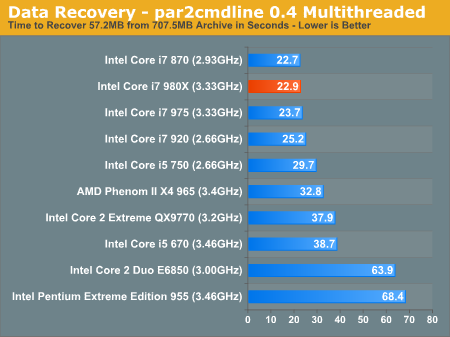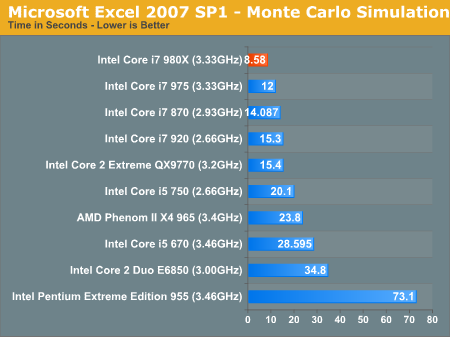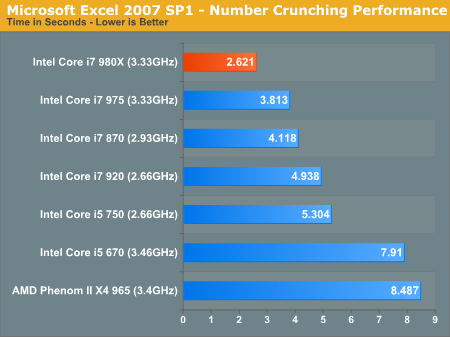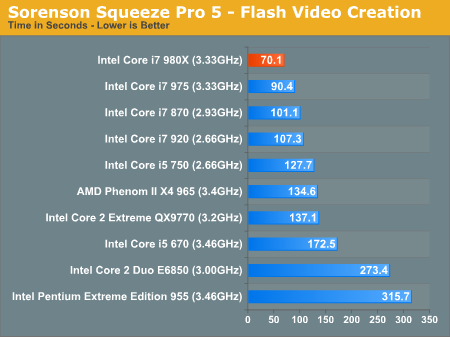The Core i7 980X Review: Intel's First 6-Core Desktop CPU
by Anand Lal Shimpi on March 11, 2010 12:00 AM EST- Posted in
- CPUs
PAR2 Multithreaded Archive Recovery Performance
Par2 is an application used for reconstructing downloaded archives. It can generate parity data from a given archive and later use it to recover the archive
Chuchusoft took the source code of par2cmdline 0.4 and parallelized it using Intel’s Threading Building Blocks 2.1. The result is a version of par2cmdline that can spawn multiple threads to repair par2 archives. For this test we took a 708MB archive, corrupted nearly 60MB of it, and used the multithreaded par2cmdline to recover it. The scores reported are the repair and recover time in seconds.

An application needs to be more than multithreaded to take advantage of the 980X, it needs to demand more than four threads. And our PAR2 test is pushing it as is, there's no advantage to the 980X here.
WinRAR - Archive Creation
Our WinRAR test simply takes 300MB of files and compresses them into a single RAR archive using the application's default settings. We're not doing anything exotic here, just looking at the impact of CPU performance on creating an archive:

Our WinRAR test takes advantage of the larger L3 cache and thus we see roughly a 9% performance advantage for the 980X compared to the 975.
Microsoft Excel 2007
Excel can be a very powerful mathematical tool. In this benchmark we're running a Monte Carlo simulation on a very large spreadsheet of stock pricing data.

If you're running any sort of computationally intensive Excel macros, the 980X will deliver. The financial market just wet themselves.

Sony Vegas Pro 8: Blu-ray Disc Creation
Although technically a test simulating the creation of a Blu-ray disc, the majority of the time in our Sony Vegas Pro benchmark is spend encoding the 25Mbps MPEG-2 video stream and not actually creating the Blu-ray disc itself.

Even when the application doesn't scale perfectly with core count, we still see some impressive gains. Our MPEG-2 Blu-ray creation test showed a hefty 20% performance improvement over the 975. If you do any sort of video encoding or Blu-ray authoring, the 980X is perfect for you.
Sorenson Squeeze: FLV Creation
Another video related benchmark, we're using Sorenson Squeeze to convert regular videos into Flash videos for use on websites.

FLV authoring shows another healthy gain of 30% over the quad-core 975.










102 Comments
View All Comments
softdrinkviking - Thursday, March 11, 2010 - link
it's a 2-p4 mcm at at a lower node with a lotof improvements over the older p4 manufacturing processes.
if i absolutely had to have netburst, that's what i would want.
i think it's really nice that Anand includes it in the comparison, because it gives a sense of history to the article, and it shows how much faster CPUs have gotten in such a short time.
JonnyDough - Thursday, March 11, 2010 - link
Yep. It might be based on P4, but you can't really considered a P4. It was based on two cedar mill cores rather than smithfield with double the cache and a 200mhz bus speed jump.Dadofamunky - Thursday, March 11, 2010 - link
And exactly the same NetBurst architecture otherwise. And I'm sorry, but seeing that POS coming up with 40% against Gulftown signifies either one of two things: Gulftown isn't that much faster; or, the SysMark software distorts the relative performance results. That isn't a realistic portrayal of 'history.' SysMark 2007 badly needs an update. It isn't a realistic tool for the 4-to-6-core world.danielkza - Thursday, March 11, 2010 - link
Weird, other sites managed to squeeze up to 4.4GHz of the 980X on air, and 4.7GHz on WC. I thought initially of different stability requirements from both parts, but bit-tech ran all their benchmarks at both 4400MHz and 4720MHz. Maybe Anand's DX58 isn't holding up so well after all.http://www.bit-tech.net/hardware/cpus/2010/03/11/i...">http://www.bit-tech.net/hardware/cpus/2...-core-i7...
DanNeely - Thursday, March 11, 2010 - link
Anand only used a stock cooler to test. The intel coolers never have much head room in them. Luck of the draw in both mobo and CPU might be a factor but so is bit-tech's better cooling.chrisfam - Thursday, March 11, 2010 - link
Tomshardware got a 4.13 Ghz overclock with 1.4v and with Enhanced SpeedStep and Turbo Boost enabled. Neoseeker got a 4.16 Ghz overclock with just 1.35v. And both of these were with the stock heat sink.Anand Lal Shimpi - Thursday, March 11, 2010 - link
I've been working on a follow up to go deeper into our overclocked numbers. A motherboard swap later and a little bit of work appears to be paying off...I'm over 4.1GHz already :-)Update soon!
Take care,
Anand
chrisfam - Thursday, March 11, 2010 - link
Updated overclock (4.13 Ghz, 1.359V) is much better. Thanks for the update.Rajinder Gill - Thursday, March 11, 2010 - link
That's right, 3.7-3.8GHz is the full load limit of Intel's stock cooler with these beasts. We ran out of time to really push, but I'm sure we'll find out what these chips can do in due course.regards
Raja
strikeback03 - Thursday, March 11, 2010 - link
Is the new tower cooler an improvement in any way over the old one? Is it quieter, as it doesn't seem to offer more OC headroom.Also, how does the CPU power consumption increase by 130W at load over idle, while system consumption only goes up 90W?